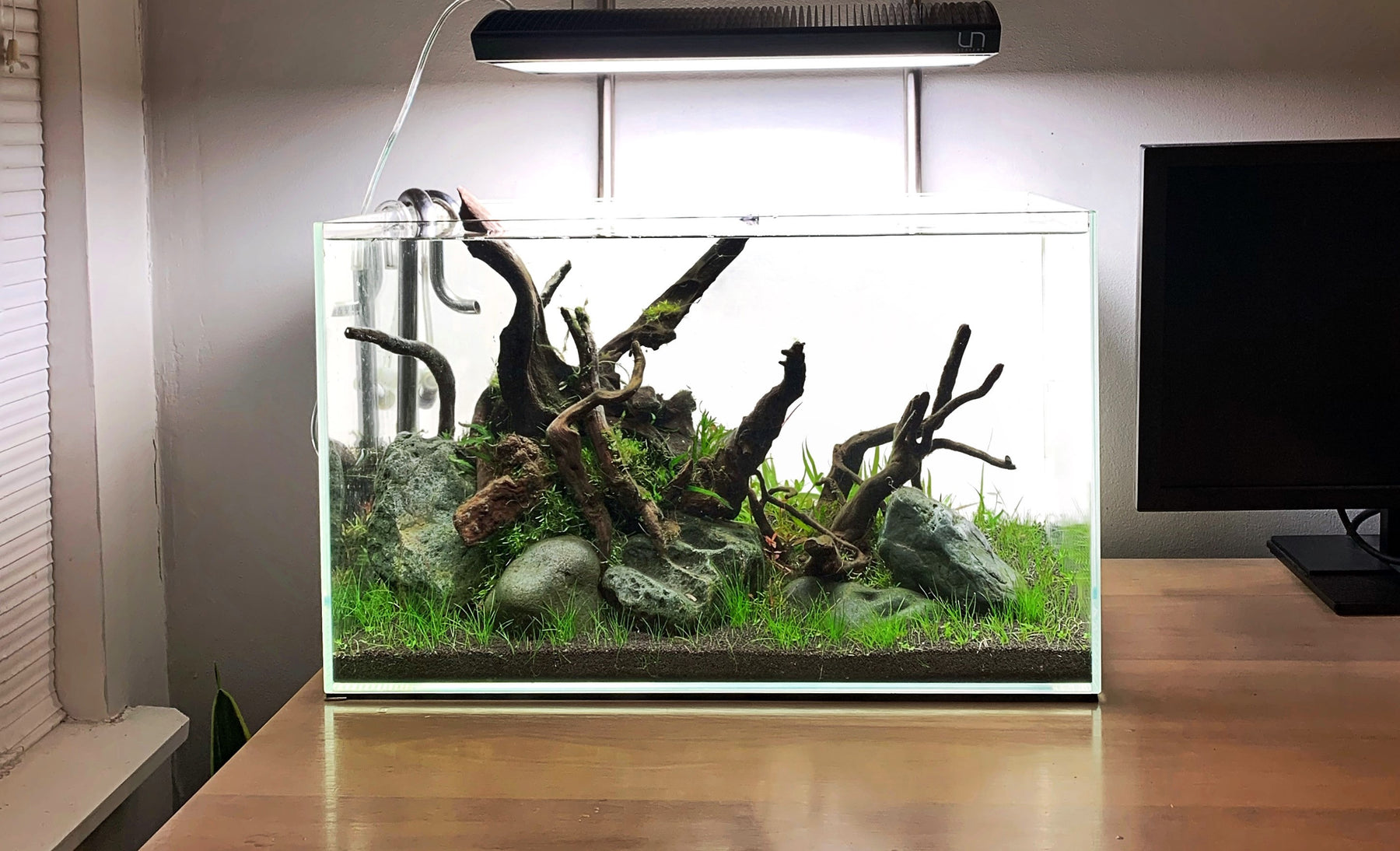
Creating a Classic Nature Aquarium Scape
Written By: Chris (@shrimpery)
My non-internet friends occasionally ask me how many hours I spend on my planted aquariums each week. They are sometimes surprised to learn that I only spend about an hour or so trimming the plants, replanting cuttings, water changes, cleaning the glass, and feeding the fish. A caveat, though: this only applies to well-established tanks. A brand new tank can take half a day or more to set up and requires frequent maintenance in the ensuing weeks.
Despite this extra time commitment, setting up a new aquascape is one of the most rewarding parts of the hobby, with hobbyists often spending months plotting on their next layout. With this in mind, I thought that I would share my own thought process and the approach that went into setting up my newest aquascape.

For a successful aquascape, one must have a good canvas to work with. In this case, I used a classic UNS 60U tank, with the powerful UNS Titan light fixture and accompanying hanging bar. I also used an inline heater on my oversized external canister filter. As always, I recycled filter media from an existing scape to jumpstart the cycle. Similarly, I typically recycle at least some of the substrate in my tanks to add beneficial bacteria.
Most of my aquascapes have been heavy on the aquatic plants, with relatively undersized hardscape. As I grew as an aquascaper, what started as a miscalculation on my part (smaller hardscape looks great when first planted but tends to get lost in the mix once the plants really fill in) became an intentional choice to best show off my favorite aspect of the hobby: healthy, vibrant plants. For my newest scape, the idea was to go for a truly classic nature aquarium, with prominent but balanced hardscape, a full carpet, and primarily green stem plants with hints of color here and there.

One somewhat counterintuitive trick to create a greater sense of depth in your aquascape: always make the hardscape closer to the front of the glass than seems appropriate. This way, the bushy, dense stems behind the hardscape will seem almost like a dense forest. In my own tank, the small scale of the leaves of both the carpeting plants and the stems will add to that sense of scale as the tank matures.
For hardscape, I utilized many large pieces of Hakkai stone, which is a rounded, bluish greyish river rock. For driftwood, I chose large, branching pieces of darker wood to make a strong impression. I oriented the hardscape in a triangular pattern, sloping from the right side of the tank down to left side of the tank (left to right from viewer’s perspective). In front of the hardscape and immediately to the side of it, in a sort of L shape, I planted Dwarf Hair Grass in UNS controsoil. Here and there, I also planted a few sprigs of Micranthemum ‘Monte Carlo’ for greater textural interest. On the hardscape itself, I affixed numerous epiphytes including Riccardia, Christmas moss, and Java fern. I stuffed some pieces of Utricularia Graminifolia in between the nooks and crannies of the wood.

Behind the hardscape, I planted my selection of stem plants. On the viewer’s left side of the tank, I planted a variety of colorful Rotalas, most prominently Rotala ‘colorata’ and ‘Fujian’. Moving to the viewer’s right, I planted rows of Nesaea pedicellata "Golden,” which is a rich yellow under peak conditions, unlike any other aquatic plant in the hobby. I also planted some Ludwigia arcuata and Ludwigia sp. ‘super red.’ This was another departure from my typical approach, as I generally mix different stems together with less regard for groupings by type and color. Towards the middle of the back part of the tank, I planted green stem plants, consisting mainly of Rotala ‘green.” I also added some Juncus repens, aquatic mint, and Sphaerocaryum at the outer fringes of the grouping. In the small “middle ground” area, I added some Persicaria (Polygonum) sp. 'Sao Paulo' for some color contrast against the greens.

Reviewing the finished product, I am satisfied with the scape in general, although it is hard to tell how things will evolve as the scape settles in and the plants begin to take off. In the meantime, I will be doing frequent water changes to combat diatoms until the plant mass increases. The best thing about aquascaping is the flexibility: if you don’t like a plant in a particular location, you can easily replant it or remove it altogether. If I find myself bored with the foreground, I can replace the front part of the carpet with cosmetic sand, for example. This is a challenging but creative hobby- much like the field of medicine, there is both science and art involved. Don’t be afraid to mix things up in your own scape- or sit back and watch things unfold in beautiful and unpredictable ways.

Tell us - What do you think about this aquascape? Comment your thoughts!
If you have any questions regarding this article, please DM us on Facebook or Instagram so we can assist you! @buceplant





Comments
Leave a comment